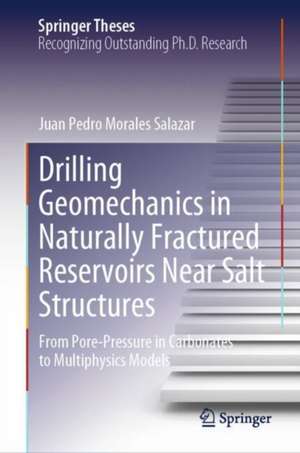Drilling Geomechanics in Naturally Fractured Reservoirs Near Salt Structures: From Pore-Pressure in Carbonates to Multiphysics Models: Springer Theses
Autor Juan Pedro Morales Salazaren Limba Engleză Hardback – mai 2024
Din seria Springer Theses
- 18%
 Preț: 997.88 lei
Preț: 997.88 lei -
 Preț: 389.88 lei
Preț: 389.88 lei - 15%
 Preț: 646.94 lei
Preț: 646.94 lei - 18%
 Preț: 943.43 lei
Preț: 943.43 lei -
 Preț: 399.29 lei
Preț: 399.29 lei - 18%
 Preț: 944.99 lei
Preț: 944.99 lei - 15%
 Preț: 636.80 lei
Preț: 636.80 lei - 18%
 Preț: 941.05 lei
Preț: 941.05 lei - 15%
 Preț: 643.16 lei
Preț: 643.16 lei - 15%
 Preț: 642.68 lei
Preț: 642.68 lei - 18%
 Preț: 1103.62 lei
Preț: 1103.62 lei - 20%
 Preț: 558.82 lei
Preț: 558.82 lei - 18%
 Preț: 1112.30 lei
Preț: 1112.30 lei - 18%
 Preț: 944.19 lei
Preț: 944.19 lei - 18%
 Preț: 1109.92 lei
Preț: 1109.92 lei - 18%
 Preț: 1217.27 lei
Preț: 1217.27 lei - 15%
 Preț: 640.06 lei
Preț: 640.06 lei - 15%
 Preț: 636.45 lei
Preț: 636.45 lei - 15%
 Preț: 640.06 lei
Preț: 640.06 lei - 15%
 Preț: 640.88 lei
Preț: 640.88 lei -
 Preț: 389.70 lei
Preț: 389.70 lei - 20%
 Preț: 563.89 lei
Preț: 563.89 lei -
 Preț: 393.35 lei
Preț: 393.35 lei - 15%
 Preț: 637.93 lei
Preț: 637.93 lei - 15%
 Preț: 641.85 lei
Preț: 641.85 lei - 18%
 Preț: 1225.94 lei
Preț: 1225.94 lei - 20%
 Preț: 551.36 lei
Preț: 551.36 lei - 18%
 Preț: 1229.10 lei
Preț: 1229.10 lei - 15%
 Preț: 639.25 lei
Preț: 639.25 lei - 18%
 Preț: 999.45 lei
Preț: 999.45 lei - 15%
 Preț: 640.06 lei
Preț: 640.06 lei - 18%
 Preț: 1220.45 lei
Preț: 1220.45 lei - 18%
 Preț: 1116.26 lei
Preț: 1116.26 lei - 18%
 Preț: 1110.72 lei
Preț: 1110.72 lei - 18%
 Preț: 1000.87 lei
Preț: 1000.87 lei - 18%
 Preț: 891.17 lei
Preț: 891.17 lei - 15%
 Preț: 640.06 lei
Preț: 640.06 lei - 5%
 Preț: 1154.07 lei
Preț: 1154.07 lei - 15%
 Preț: 635.96 lei
Preț: 635.96 lei - 15%
 Preț: 640.88 lei
Preț: 640.88 lei -
 Preț: 387.20 lei
Preț: 387.20 lei - 18%
 Preț: 1109.92 lei
Preț: 1109.92 lei -
 Preț: 385.25 lei
Preț: 385.25 lei -
 Preț: 385.25 lei
Preț: 385.25 lei - 18%
 Preț: 1112.30 lei
Preț: 1112.30 lei - 18%
 Preț: 999.45 lei
Preț: 999.45 lei -
 Preț: 386.99 lei
Preț: 386.99 lei - 15%
 Preț: 637.13 lei
Preț: 637.13 lei - 20%
 Preț: 554.20 lei
Preț: 554.20 lei - 20%
 Preț: 555.57 lei
Preț: 555.57 lei
Preț: 1108.99 lei
Preț vechi: 1352.42 lei
-18% Nou
Puncte Express: 1663
Preț estimativ în valută:
212.24€ • 219.89$ • 177.12£
212.24€ • 219.89$ • 177.12£
Carte disponibilă
Livrare economică 28 februarie-14 martie
Preluare comenzi: 021 569.72.76
Specificații
ISBN-13: 9783031565243
ISBN-10: 303156524X
Pagini: 200
Ilustrații: XXI, 153 p. 94 illus., 85 illus. in color.
Dimensiuni: 155 x 235 mm
Greutate: 0.45 kg
Ediția:2024
Editura: Springer Nature Switzerland
Colecția Springer
Seria Springer Theses
Locul publicării:Cham, Switzerland
ISBN-10: 303156524X
Pagini: 200
Ilustrații: XXI, 153 p. 94 illus., 85 illus. in color.
Dimensiuni: 155 x 235 mm
Greutate: 0.45 kg
Ediția:2024
Editura: Springer Nature Switzerland
Colecția Springer
Seria Springer Theses
Locul publicării:Cham, Switzerland
Cuprins
Introduction.- Pore-Pressure for Carbonates.- Coupled Geomechanics and Fluid Flow in Naturally Fractured Reservoirs.- Rheology of Salt Rocks.- Coupled Poroelasticity Viscoelasticity Model.- Conclusions
Notă biografică
Juan Pedro Morales Salazar is a drilling and geomechanics scientist; he is also a consulting professor of petroleum engineering subjects at the School of Engineering at the National Autonomous University of Mexico (UNAM). Currently, he works at PEMEX-PEP as an external technical advisor in different topics regarding geomechanics applied to well drilling, pore pressure prediction, pressure management drilling, drilling transient flow and cutting transport, hydraulic fracturing, directional drilling, cementing, among others. He holds a B.S. degree, a M.S. and Ph.D. all in petroleum engineering from the UNAM. He is a SPE member and has had many presentations in technical conferences in the Mexican Petroleum Congress (CMP) and the Mexican Petroleum Engineering Association meetings (AIPM).
Textul de pe ultima copertă
This book explains different phenomena that occur in Naturally Fractured Reservoirs (NFRs) of carbonate rocks neighboring a salt structure and how it affects well drilling. Prediction of carbonate pore pressure is difficult; therefore, a new set of pore pressure equations for carbonates were developed, accounting for overpressure and depleted conditions. A detailed description of a fully coupled model is shown in order to discuss geomechanics and the coupling of fluid flow in porous media and to achieve a better representation of the mechanics involved in the exploitation of NFRs. Additionally, results of a new model of geomechanics in vuggy carbonate reservoirs are presented. This book also displays a wide discussion, analysis, and numerical implementation of six different salt rheology models. Furthermore, the most representative rheology salt models were studied aside with the fully coupled model of geomechanics and fluid flow in porous media. Finally, it presents an answer to a real case of a well drilled near a salt diapir where anomalous pore pressure was found.
Caracteristici
Proposes new pore pressure equations for carbonates Presents a new model of geomechanics in vuggy carbonate reservoirs Provides insights to real drilling cases
